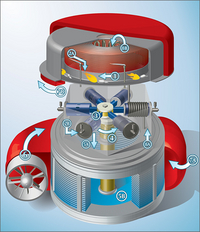Waste Oil Power Generator from Cyclone Power Technologies and Phoenix Power Group Demonstrates Clean Emissions
POMPANO BEACH, Fla.--Cyclone Power Technologies and its licensee Phoenix Power Group (PPG) have announced positive results of preliminary emissions testing of the combustion system of the Phoenix 10, the first ever small-scale waste oil power generator.
Running on used motor oil in tests conducted by an independent third party, the Phoenix 10 generated 30% less SO2 and almost 50% less NOx than a comparable generator running on diesel fuel. Acceptable emissions of SO2 and NOx required by many state environmental agencies are below 5 tons per year. The Phoenix 10 demonstrated emissions of only 0.14 and 0.13 tons respectively of these toxic gases (based on a full 4368 hour year), using a waste fuel product that other small power systems are incapable of accepting.
The reason for these extremely clean readings is Cyclone's WHE-25 engine which powers the Phoenix 10. As an external combustion engine, the WHE-25 is able to combust any fuel , even used motor oils at temperatures and pressures below where many gasses such as NOx are formed. Other noxious particles are incinerated in the long combustion residence of the engine's cyclonic chamber. Tested on diesel fuel for comparison purposes, the WHE-25 had approximately one-tenth of the SO2 and NOx emissions of a diesel internal combustion engine.
"We are pleased with these preliminary findings, but not surprised," stated Doug Petty, Vice President of PPG. "We know that the Cyclone engine is capable of combusting used oil in an environmentally sound manner, and thereby providing producers of this waste product with an alternative, revenue producing method of disposal."
According to the U.S. Environmental Protection Agency, waste oil from one oil change can contaminate 1 million gallons of fresh water. The Phoenix 10 presents a true economic incentive for users of motor oil to dispose of their waste in an environmentally friendly manner instead of one which can cause great harm to our water supply.
The Phoenix 10 prototype will be unveiled at Power-Gen International in Orlando, December 14-16. The system will allow thousands of oil change service centers and other waste oil producing locations to recycle their used motor oil in an environmentally-friendly and profitable manner by producing up to 10kW of electricity.
Cyclone and PPG will conduct a more broad-spectrum emission study during the system's pilot testing commencing in the beginning of 2011, and will announce those results when available. Emission testing was conducted by Alliance Source Testing of Decatur, AL.
CORPORATE PROFILE
Cyclone Power Technologies is the developer of the award-winning Cyclone Engine an eco-friendly external combustion engine with the power and versatility to run everything from portable electric generators and garden equipment to cars, trucks and locomotives. Invented by company founder and CEO Harry Schoell, the patented Cyclone Engine is a modern day steam engine, ingeniously designed to achieve high thermal efficiencies through a compact heat-regenerative process, and to run on virtually any fuel - including bio-diesels, syngas or solar - while emitting fewer greenhouse gases and irritating pollutants into the air. Currently in its late stages of development, the Cyclone Engine was recognized by Popular Science Magazine as the Invention of the Year for 2008, and was presented with the Society of Automotive Engineers' AEI Tech Award in 2006 and 2008. Additionally, Cyclone was recently named Environmental Business of the Year by the Broward County Environmental Protection Department. For more information, visit www.cyclonepower.com.
Key To Image Numbers:
HEAT PROCESS
1. Fuel is atomized and injected into the patented centrifugal combustion chamber (shown as lifted off the engine block for better viewing), where a spark ignites the fuel-air mixture into a flame that spins around the heat coils. Thermocouples (not pictured) control the duration of combustion to keep the heat in the combustion chamber at a constant temperature.
2. Water contained in the coils becomes super-heated steam (up to 1200°F) in as little as 5 seconds from start up which is (a) piped to the cylinders, (b) where it enters through a patent-pending valve system (not pictured). Note, valve timing mechanisms regulate how much steam enters the cylinders – the longer the cut-off the greater the torque and acceleration.
MECHANICAL PROCESS
3. Steam enters the six radial-configured cylinders under pressures up to 3200 psi to push the pistons down in sequence. Note, no motor oil is used – water is both the working fluid and engine lubricant. Also, because of the valve design, the engine starts without the need of a starter motor.
4. The rotating action of the pistons connected through a patent-pending spider bearing (not pictured) turns the crank shaft. Note, because the greatest amount of torque occurs at the first rotation, the shaft can be directly connected to a drive train without a transmission.
COOLING PROCESS
5. Steam escapes the cylinders through exhaust ports and (a) enters the patent-pending condensing unit where it turns back into water, and (b) collects in a sealed pan at the bottom of the condenser. Note, this is a closed-loop system – the water does not need to be replaced or topped-off.
6. Blowers spin fresh air around the condenser to speed the cooling process.
REGENERATIVE PROCESS
7. (a) Air which has been pre-heated from the condensing unit, (b) continues up to a second heat exchanger located in the exhaust port of the combustion chamber, further pre-heating the air used for combustion while also cooling the exhaust fumes (to about 320°F).
8. A high pressure pump (not pictured) pipes water from the collecting pan to the heat coils (a) via heat exchangers surrounding each of the cylinders (only one pictured), and then (b) to the center of the coils to start the heat cycle again.



